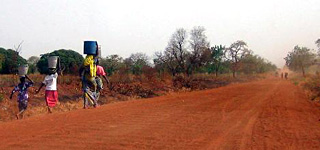
Lacking proper infrastructure for safe drinking water, women and children in Tamale, Ghana walk many kilometers each day carrying heavy loads of water to their families. This situation is mirrored in many other parts of the world. (Photograph courtesy of Jenny VanCalcar. Used with permission.)
Instructor(s)
Susan Murcott
MIT Course Number
11.479J / 1.851J
As Taught In
Spring 2007
Level
Graduate
Course Description
Course Features
Course Description
This course deals with the principles of infrastructure planning in developing countries, with a focus on appropriate and sustainable technologies for water and sanitation. It also incorporates technical, socio-cultural, public health, and economic factors into the planning and design of water and sanitation systems. Upon completion, students will be able to plan simple, yet reliable, water supply and sanitation systems for developing countries that are compatible with local customs and available human and material resources. Graduate and upper division students from any department who are interested in international development at the grassroots level are encouraged to participate in this interdisciplinary subject.
Acknowledgment
This course was jointly developed by Earthea Nance and Susan Murcott in Spring 2006.
Other Versions
Other OCW Versions
OCW has published multiple versions of this subject. ![]()


